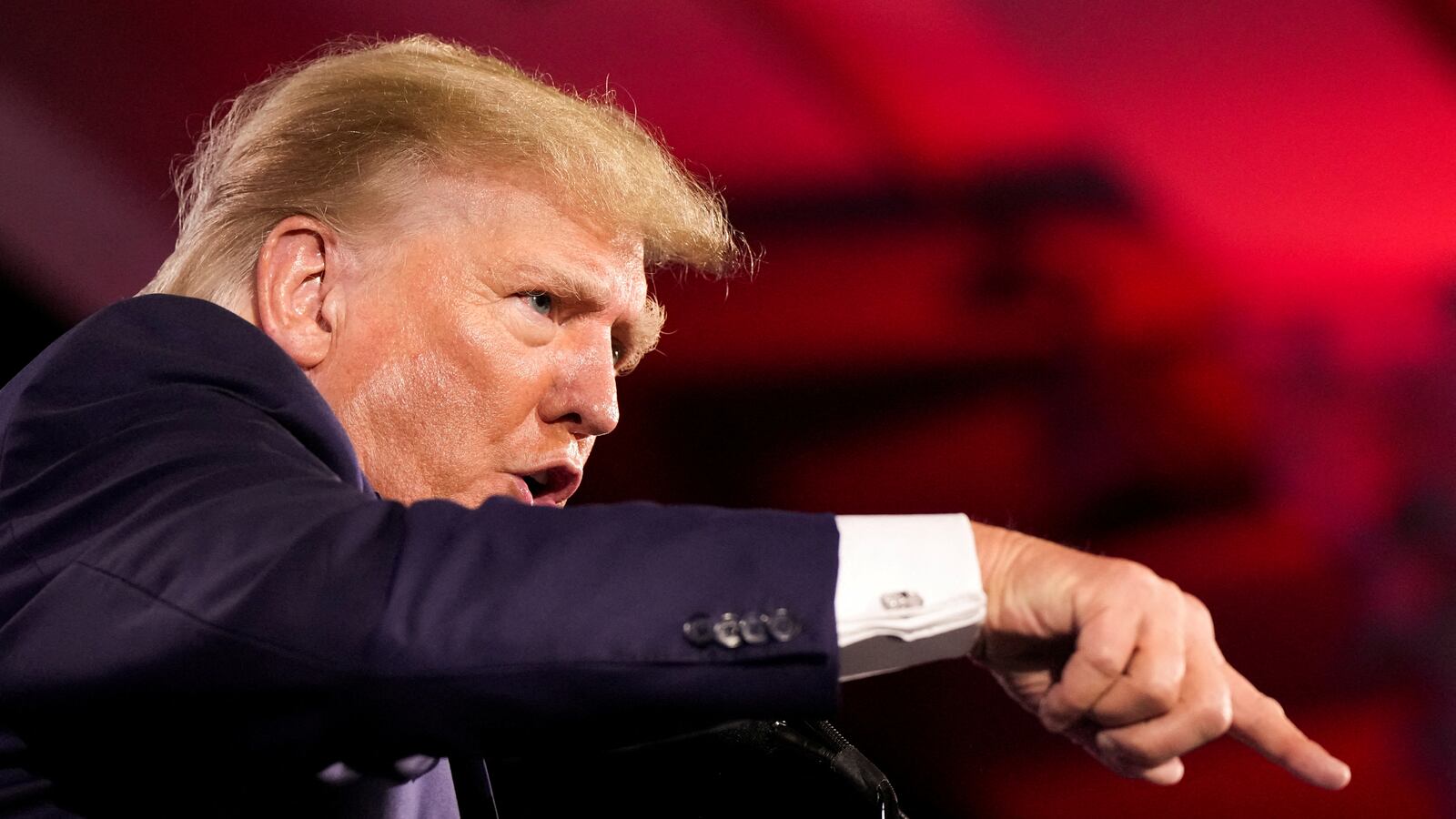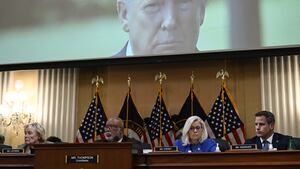As the Jan. 6 committee’s explosive string of televised hearings resumed Tuesday, the panel focused on “three rings” of the insurrection: Former President Donald Trump’s inside pressure campaign to persuade his vice president to overturn the electoral votes, the coordination between right-wing extremist groups to violently sack the Capitol, and the force of a MAGA crowd willing to march alongside them.
“All of these efforts would converge and explode on January 6th,” Rep. Jamie Raskin (D-MD), a member of the congressional panel, said Tuesday.
Raskin added that “the problem of politicians whipping up crowds” was “the oldest domestic enemy of constitutional democracy in America.”
But Trump’s decision to order his angry followers to march on the Capitol on Jan. 6, 2021 wasn’t spontaneous. The committee on Tuesday afternoon revealed a draft tweet that Trump wrote but never sent telling people, “Please arrive early, massive crowds expected, March to the Capitol after. Stop the Steal!!”
The committee also disclosed White House call logs that showed Trump twice spoke to right-wing provocateur Steve Bannon twice on the morning of Jan. 5 shortly before Bannon took to his podcast to announce, “All hell is going to break loose tomorrow. It's all converging, and we're on the point of attack.”
But the biggest bombshell of the hearing came in its final seconds, when Rep. Liz Cheney (R-WY), the committee’s co-chair, revealed that Trump recently tried to reach an undisclosed witness who has yet to testify. The matter, Cheney said, was referred to the Department of Justice.
The revelation is an obvious warning to stop Trump and his associates from further intimidating insiders who are willing to speak to investigators—and is a shot across the bow with the threat of criminal charges for witness tampering. A Trump spokeswoman and his attorneys did not immediately respond to a request for comment.
So far, the Republican Party—very much still under the spell of Trump—has lambasted these congressional hearings as a proxy attack on the former president. But the committee’s seventh hearing is already showing something that goes well beyond politics: the direct connection between a president who refused to leave office and armed insurrectionists who played a pivotal role in his attempt to interrupt the transfer of power.
At least three groups with ties to fascists and white supremacists—the Oath Keepers, the Three Percenters, and the Proud Boys—served as bodyguards to Trump associates in the run-up to the insurrection. They also played pivotal roles in pushing past police lines on Jan. 6, 2021.
The chairman of the congressional panel, Rep. Bennie Thompson (D-MS), started the hearing by criticizing Trump’s refusal to concede in the weeks after the 2020 election and his role in the nation’s capital that day. “He seized on the anger he had already stoked among his … supporters. He didn’t wave them off. He urged them on.”
“Donald Trump summoned a mob to Washington, D.C., and ultimately spurred that mob to wage a violent attack on our democracy.”
On Tuesday, the committee also revealed that Trump went out of his way to insert menacing references to Mike Pence, the vice president who he felt betrayed him.
An initial draft of his speech at the Ellipse park south of the White House on Jan. 6 made no reference to Pence. White House records show that an angry reference to Pence was added after a chat that morning between Trump and his hardline rightwing political adviser, Stephen Miller.
That reference was quickly cut by speechwriters who knew better. But then Pence told Trump one final time that he was not willing to break with tradition—and violate the law—by abusing his role as president of the Senate and refusing to officially count electoral ballots. Shortly thereafter, special assistant to the president Robert Gabriel Jr. wrote an email to staff: “REINSERT THE MIKE PENCE LINES.”
By sorting through White House records, the committee also spotted how Trump ad-libbed and turned that single Pence reference into a total of eight. He took one reference to marching on the Capitol and repeated it three more times. His additions included, “Let's walk down Pennsylvania Avenue,” and, “We fight like hell, and if you don’t fight like hell, you're not gonna have a country anymore.”
Cheney, the top Republican on the committee, noted that Trump should have known better than to continue to espouse conspiracy theories about the election results.
"Donald Trump is a 76-year-old man,” she said. “He is not an impressionable child.”
Providing further proof that the ex-commander in chief should have called it quits before the day of the insurrection, the panel played clips of interviews with Trump’s labor secretary, Eugene Scalia, and his former White House counsel, Pat Cipollone, in which they both stated that Trump should have conceded when presented with the overwhelming evidence that he lost to Joe Biden in 2020.
Even Trump’s own digital guru, Brad Parscale, laid the blame for the violence at his boss’s feet. He and spokeswoman Katrina Pierson, who both worked on Trump’s 2016 presidential campaign together, texted each other while the pepper spray was still being aired out of the Capitol building the evening of the assault.
“This is about Trump pushing for uncertainty in our country. A sitting president asking for civil war. This week I feel guilty for helping him win,” Parscale wrote to Pierson, according to texts acquired by the committee.
“You did what you felt right at the time and therefore it was right,” Pierson responded.
“Yeah. But a woman is dead,” Parscale said, referring to Ashli Babbitt, who was shot to death by a police officer as she and other protestors tried to break into the Speaker’s Lobby on their way to the House of Representatives Chamber.
At Tuesday’s hearing, the committee more closely explored the odd, middle-of-the-night Trump tweet that called his loyal followers to Washington in the first place.
“Statistically impossible to have lost the 2020 Election. Big protest in D.C. on january 6th. Be there, will be wild!” Trump tweeted at 1:42 a.m. on December 19, 2020.
It’s now clear why the nation’s top politician was up so late that Friday night. He was fired up after having an hours-long impromptu meeting in which conspiracy theorists Sidney Powell, Michael Flynn, and Patrick Byrne tried to convince him to take illegal action to seize voting machines—while White House lawyers desperately tried to shut it all down before it got out of hand.
At one point, White House aide Cassidy Hutchinson texted Trump’s deputy chief of staff Anthony Ornato, “The west wing is UNHINGED.”
On Tuesday, the committee played clips of interviews with several of the people in the Oval Office that day who recounted the constant shouting matches that nearly came to blows between White House lawyer Eric Herschmann and Flynn, a retired Army general who lost his post as Trump’s national security adviser for lying to the FBI.
At one point, Powell asserted that corrupt judges were to blame for the utter failure of her campaign of deranged “Kraken” lawsuits that attempted to overturn the election in several states.
“They said judges are corrupt. I said, ‘Everyone? Every single case that you've done? Even the ones that we've appointed?’” Herschmann recalled during his recorded interview.
During her taped interview with the committee, Powell remembered Trump appointing her as “special counsel” with a security clearance and the power to seize voting machines across the country pursuant to a draft executive order she had helped devise—an idea unilaterally opposed by White House lawyers and then-Attorney General Bill Barr.
"I was vehemently opposed. I didn't think she should be appointed to anything," ex-White House counsel Pat Cipollone told the committee during a videotaped interview last week. He and other White House lawyers put up a fight and never went through with the proposed plan.
Trump’s response was that of a frustrated king. According to Powell, the president lamented, “You see what I deal with? I deal with this all the time.”
Although the committee’s previous six hearings have largely relied on its own work, via recorded depositions conducted by the panel and its investigators, this time around, the committee has gotten quite a bit of help from the massive assortment of criminal investigations currently underway by the Department of Justice.
As federal agents have been hunting down those who attacked cops, trespassed into the building, and wreaked havoc that day, federal prosecutors have been building complex criminal cases that allege certain groups were engaged in a violent plot to potentially kill people to keep Trump in power.
More than a dozen members of MAGA-loyal militias face an extremely rare and serious criminal charge of seditious conspiracy. That includes Oath Keepers leader Elmer Stewart Rhodes, and the one-time head of the Proud Boys street gang, Enrique Tarrio. Law enforcement working on these cases have revealed that militants stored caches of weapons and survival gear just outside the nation’s gun-free capital, with plans to ferry them across the Potomac River if a large-scale battle ensued. These criminal cases are slowly making their way to trial.
The U.S. Attorney’s Office for the District of Columbia and the FBI’s Washington field office have essentially been transformed in the wake of the Jan. 6, 2021 attack. According to numbers updated last week, the feds have arrested more than 855 people in every state of the country. So far, 166 of them have been sentenced to prison or home confinement. But the increasingly Trump-loyal Republican Party has oddly rallied around these jailed insurrectionists, with politicians like Rep. Marjorie Taylor Greene (R-GA) fundraising on the idea that these attackers are being prosecuted improperly.
On Tuesday before the hearing, George Washington University political science professor Lara Brown told The Daily Beast that understanding the role of paramilitaries on Jan. 6, 2021 deserves a closer look at the infamous “Brooks Brothers Riot” in Miami two decades ago.
Back then, Trump-loyal associate and Republican operative Roger Stone staged an organized protest that interrupted the counting of ballots in Miami-Dade County following the contested presidential election in Florida. Brown said the 2021 insurrection was the same thing on a much larger scale. And once again, Stone was involved, walking the streets of the capital and calling for an assault on the democratic process.
“This was just the next level of the Brooks Brothers Riot,” Brown said. “It suggests that the ultimate motive was always to stop the count and the only way all of the other plans could have worked is if they stopped the count. It was a very ambitious plan.”










